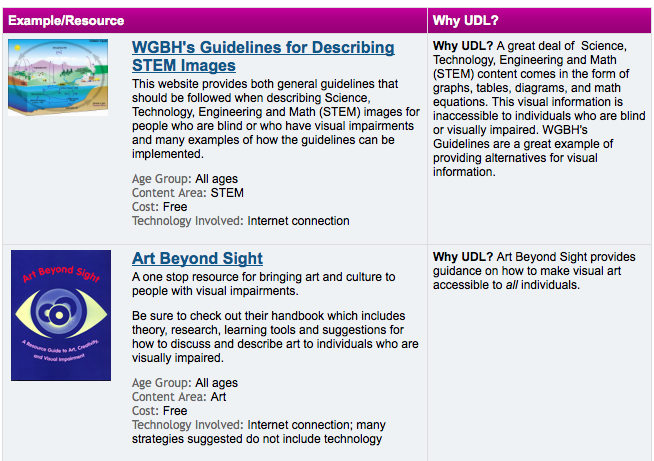Before this class, I didn’t know much about AT and UDL, but
with the help of the five sites listed below, I have been able to learn more about
AT and UDL. These five sites I
would highly recommend to any teacher!
In my previous post, I wrote about a lesson
plan I assessed to UDL guidelines. This UDL website breaks down each checkpoint and gives examples and resources to achieve
each checkpoint. Definitely a very
useful tool! The picture below shows
resources for checkpoint 1.3: Offer alternatives for visual information.
UDL Guidelines – Version 2.0 does not give resources
like my first reference, but breaks down UDL Guidelines further for a clearer
understanding. As a teacher,
understanding UDL Guidelines are useful when writing lesson plans so all
students can be successful. If unclear
about any checkpoint, one can simply go to the website for clarification. Not only is the website easy to access but
easy to navigate as well.
Cast’s website provides a video explaining the diversity of
learners and why and how we, as educators, need to modify lessons to the
students and one size does NOT fit all.
The video can be found on the link provided below.
Elements of Good Teaching is helpful to a teacher
starting their exploration of UDL. This
article defines UDL and specifies who benefits from UDL. There is also a chart, see below, on common
teaching methods and how they can be helpful and hurtful in the classroom. I found this chart very helpful when planning
a lesson plan.
The fifth reference explains guided notes, which are defined
as “instructor-prepared handouts that provide all students with background
information and standard cues with specific spaces to write key facts,
concepts, and/or relationships during the lecture,” (Heward). In classrooms today, lecture is the one of
the most popular ways of teaching. In
this article advantages and disadvantages of lecturing are given and why we
should use guided notes in the classroom.
This article gives symbols you can use in guided notes and an example that
you can model for your own class guided notes.
References:




Mia,
ReplyDeleteI agree that at the beginning of this class, I did not know much about AT and UDL, however many of the websites that you posted and blogged about have been helpful in gaining knowledge. I also put the "UDL Guidelines" and the three primary principles into my reflection blog, as I found the break down for the guidelines to be very helpful. They show how to build a lesson plan properly in order to keep students engaged and to provide opportunities for students to learn in a variety of ways.
Mia, I think the way you organized and to the point. It was also visually stimulating and pleasing. I didn't have to scroll down too far to read. I am a hands-on learner myself and your simple yet clear approach helped me organize which sites could be most useful to me.
ReplyDeleteHi Mia, I also took a look at the guided notes. As a social studies teacher, I am always trying to come up with good ways to teach the skill. Thanks for posting the information about the different symbols for guided notes. I will use them!
ReplyDelete